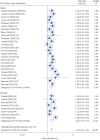The impact of body mass index on mortality in COPD: an updated dose-response meta-analysis
- PMID: 39603663
- PMCID: PMC11600125
- DOI: 10.1183/16000617.0261-2023
The impact of body mass index on mortality in COPD: an updated dose-response meta-analysis
Abstract
Background and objective: The obesity paradox is a well-established clinical conundrum in COPD patients. This study aimed to provide an updated analysis of the relationship between body mass index (BMI) and mortality in this population.
Methods: A systematic search was conducted through Embase, PubMed, and Web of Science. International BMI cut-offs were employed to define underweight, overweight and obesity. The primary outcome was all-cause mortality, and the secondary outcome was respiratory and cardiovascular mortality.
Results: 120 studies encompassed a total of 1 053 272 patients. Underweight status was associated with an increased risk of mortality, while overweight and obesity were linked to a reduced risk of mortality. A nonlinear U-shaped relationship was observed between BMI and all-cause mortality, respiratory mortality and cardiovascular mortality. Notably, an inflection point was identified at BMI 28.75 kg·m-2 (relative risk 0.83, 95% CI 0.80-0.86), 30.25 kg·m-2 (relative risk 0.51, 95% CI 0.40-0.65) and 27.5 kg·m-2 (relative risk 0.76, 95% CI 0.64-0.91) for all-cause, respiratory and cardiovascular mortality, respectively, and beyond which the protective effect began to diminish.
Conclusion: This study augments the existing body of evidence by confirming a U-shaped relationship between BMI and mortality in COPD patients. It underscores the heightened influence of BMI on respiratory and cardiovascular mortality compared to all-cause mortality. The protective effect of BMI was lost when BMI values exceeded 35.25 kg·m-2, 35 kg·m-2 and 31 kg·m-2 for all-cause, respiratory and cardiovascular mortality, respectively.
Copyright ©The authors 2024.
Conflict of interest statement
Conflict of interest: All authors have nothing to disclose.
Figures







References
Publication types
MeSH terms
LinkOut - more resources
Full Text Sources
Medical
